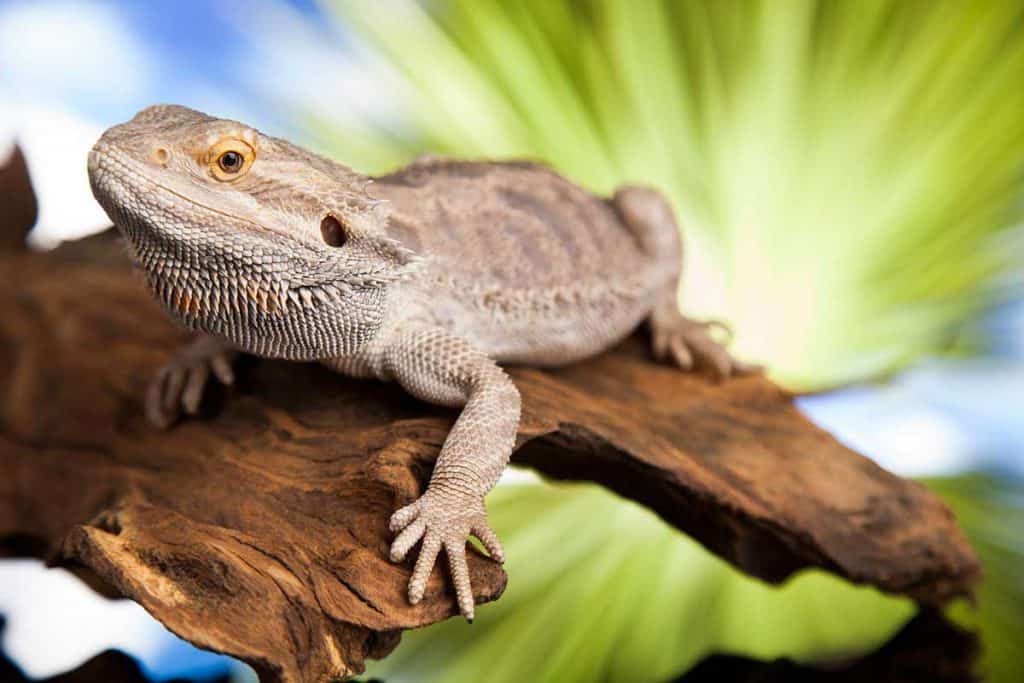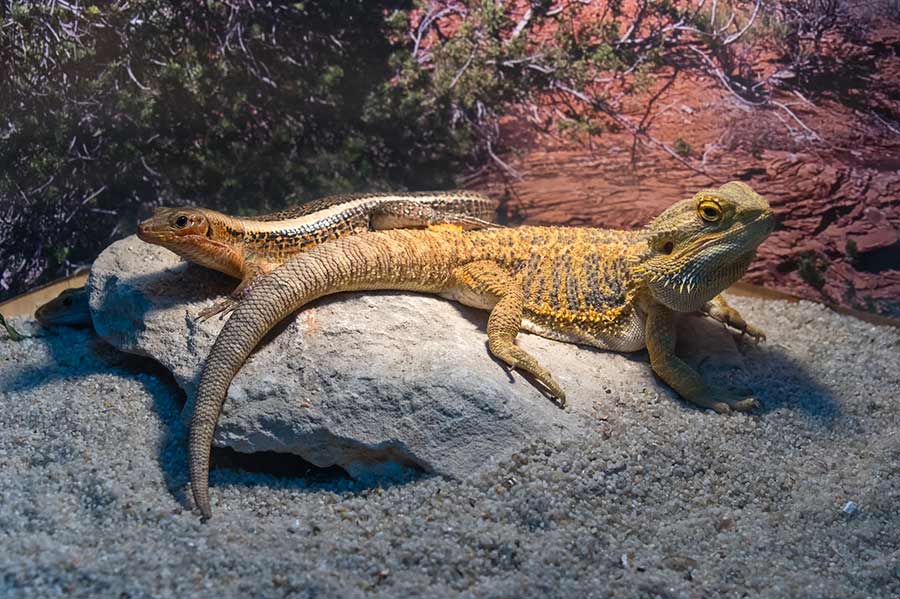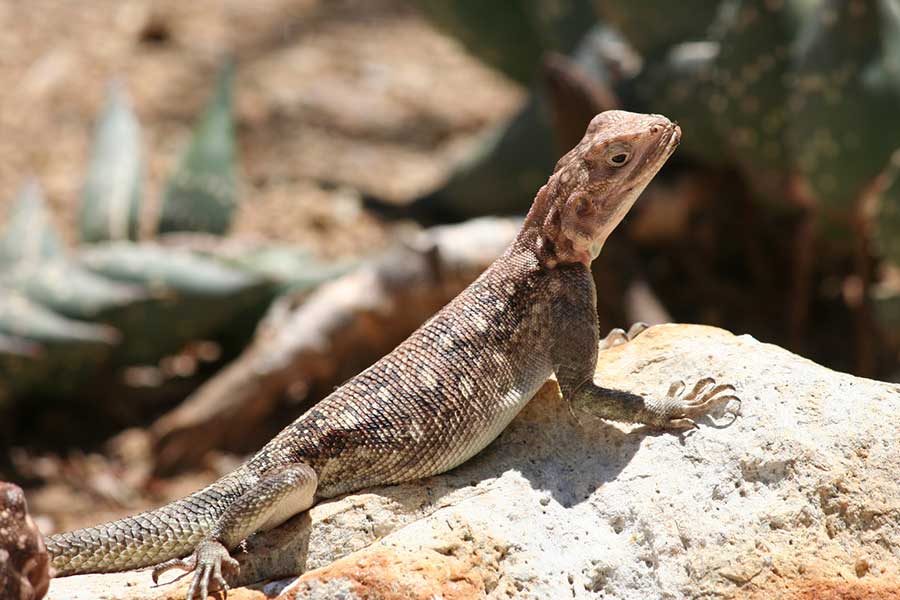Bearded dragons are the favourite pet of many reptile enthusiasts. When you get a hatchling or a juvenile, they are tiny! However, they grow and mature very quickly. If you have recently adopted one of these adorable and docile lizards, you may be wondering: how long will my bearded dragon grow for, and when do bearded dragons stop growing?
Not to worry; we have all the answers you’re looking for here! Bearded dragons generally reach maturity at the 18-month to two-year mark. Once they have reached full maturity, they will not grow any longer.
However, they can and do grow sideways! They develop healthy fat stores, strong muscles, and strong bones. Unfortunately, like many humans, bearded dragons can grow too wide because of too many yummy treats like juicy, fatty bugs! But don’t worry; you’ll be able to easily control your beardie’s caloric intake by feeding them the right insects.
There are many factors that affect a bearded dragon’s growth and how large they will eventually become upon reaching their full size. Certain factors like illness or genetic defects can affect your beardie’s growth negatively, although others like proper care and a healthy diet can affect their growth in a positive way!
We will learn about grown rates and how big bearded dragons get depending on their species, and finally have a look at some of the most important factors that affect their growth.
Growth Rate of Bearded Dragons
Bearded dragons have four main stages of growth. They grow from hatchlings to juveniles to subadults to adults. Each stage has its own set of challenges and achievements when it comes to a beardie’s growth rate.
Hatchling
At this stage of life, your bearded dragon will grow about an inch or two every month. Bearded dragons are considered hatchlings from hatching to two months of age.
Hatchling beardies grow rapidly due to their extremely fast metabolisms, so they need to eat several times a day to accommodate their growth.
Juvenile
After two months, your bearded dragon is a juvenile. Like all teenagers, juvenile bearded dragons grow like weeds! Juveniles grow between 1 and 1.5 inches every month! At this stage, they will also put on around 50 grams of weight every month.
Like hatchlings, juvenile beardies need to eat frequently, or around twice per day to help them grow into their eventual subadult and adult sizes.
Subadult
After seven months, your bearded dragon is considered a subadult! From here, your bearded dragon’s growth rate will slow down a bit. However, they will still grow steadily during this time. The subadult stage for bearded dragons lasts from when they are seven months to around 18 months.
At roughly 12 months, you’ve got a mostly full grown bearded dragon and it will not gain much more body or tail length. For the next six months to a year, they will bulk out their frames, becoming more stocky and muscular. During this time, their bodies focus on building strong muscles, especially at the base of their tails.
Adult
After 18 months to two years (24 months), your bearded dragon won’t grow any larger. At this point, they have reached their maximum length. However, they may continue to gradually put on a little more weight, especially around their tail.
Keep a careful eye out for obesity! Over the past year or two, you have become used to your beardie growing fairly quickly, and you may be tempted to feed it more to encourage this.
It is important to establish a consistent feeding schedule and maintain a healthy weight for your beardie at this time. Adult dragons should eat one large meal per day and have a diet made up of various insects, vegetables, and fruits.
Once a bearded dragon has reached adulthood at around 18 to 20 months, its growth rate will gradually slow to a complete stop.
How Big Does a Bearded Dragon Get? Full Size Per Species
There are eight species of bearded dragons in total. However, only two of them are kept commonly as pets. We will look at the average sizes of both species to help you estimate how big your bearded dragon will get, provided they are receiving proper care.
Pogona Vitticeps
Pogona vitticeps, also known as the central or inland bearded dragon, is the most commonly owned bearded dragon. It is also the bearded dragon species that all of the fancy beardies have been selectively bred from, including the massive German Giant morph, which can reach between 24 and 30 inches in length!
Pogona vitticeps grows to around 24 inches in length and is the perfect handful of roundness!
Pogona Barbata
Pogona barbata, also known as the eastern bearded dragon, is the other most commonly owned bearded dragon species.
Pogona barbata grows to 20 to 24 inches in length on average. They tend to be a bit shorter and thinner than the vitticeps variety of beardies. They also tend to have a darker colored body with more prominent spikes.
5 Factors that Negatively Affect Growth Rate
The ultimate size of your bearded dragon is largely determined by their genetics. However, certain factors can negatively affect their growth rate and stunt their growth, such as poor husbandry or prolonged stress.
The following are the top five factors that will negatively affect a bearded dragon’s growth.
1. Poor Nutrition
Bearded dragons who have a lack of vitamin D3 and
Calcium is needed to develop strong bones, muscles, and joints to support your bearded dragon’s weight. If their bones are weak, then there will be nothing for the muscle to attach to, and your bearded dragon’s growth will be negatively affected.
In order to make sure your bearded dragon gets the right amount of
Bearded dragons are territorial animals, and they strongly prefer to live alone both in the wild and in captivity.
In some cases, it is technically possible to keep multiple dragons in the same enclosure provided there is enough space, hides, food, and lighting, but this is very tricky and often risky to all lizards involved. Usually, the dragons’ personalities will clash regardless of the amount of resources they have, resulting in frequent fights and injuries.
If your bearded dragon is just not a fan of other beardies, then they will suffer if they are in the same enclosure as other bearded dragons. If you do not remove them from this situation, they will not eat properly due to the constant stress, which will affect their growth rate significantly. In severe cases, their bodies can eventually shut down entirely.
There are signs you can look for if your bearded dragon is not happy in an enclosure with other bearded dragons. Arm waving, for example, can often be a clear distress signal. Check out our guide on bearded dragon arm waving for more information on that topic.
Other behaviors like constant hiding, snapping at anyone who comes close, or frequent “black bearding” are also indicative of stress and unhappiness in bearded dragons.
3. Environmental Stress
Prolonged stress can be so bothersome that it can cause bearded dragons to stop growing entirely. This stress will typically come from their environment. If your bearded dragon’s enclosure is not kept in a quiet, calm place in your home, things like loud noises or sudden movements can quickly worsen their stress.
If your bearded dragon’s enclosure is in a particularly busy part of your home, they will be over-stimulated by all of the movement. This constant traffic and noise will keep their stress levels up.
The best way to avoid this is to simply move the enclosure to a quieter, calmer spot. If you cannot do this due to limited space in your home, provide your bearded dragon with extra hides that it can retreat to when things get chaotic.
Other environmental stressors can be things like putting the enclosure in view of an open window or other animals. This might seem like a nice view for them at first, until you realize that all manner of natural predators may be sitting in full view of your bearded dragon, which will naturally kick their survival mode into overdrive.
As a result of these environmental stressors, they will not eat or sleep properly, and their growth rate will slow down or even stop altogether.
4. Lighting and Temperature
If your bearded dragon does not have appropriate UVB lighting for their enclosure, then they will not be able to absorb and process the vitamins and nutrients they are getting from their food. Without the ability to metabolize their food properly, their growth will be stunted.
In addition, if the temperature settings are incorrect due to improper heat lighting, then your bearded dragon will not be able to thermoregulate properly. This means they won’t be able to control their metabolism and digestion. This will result in them being unable to absorb their food and grow properly.
5. Parasites
The biggest culprit for delayed or stunted growth in bearded dragons is parasite infestations. Internal parasites actively take away nutrients and food from your bearded dragon’s digestive tract before they have a chance to absorb it.
If your bearded dragon cannot absorb its own food, then it cannot grow properly.
External parasites, like mites, burrow into the skin and feed on your bearded dragon’s blood. They then infect your bearded dragon with their own parasites. This drains your bearded dragon of vital nutrients and makes them lethargic and unlikely to eat, which negatively affects their growth.
3 Factors that Aid Growth Rate
Although there are many troublesome factors that can stunt your bearded dragon’s growth, there are also plenty of ways to encourage healthy and consistent growth!
Remember, though, you can do everything right and provide them with the best care, but you cannot get them to be larger than what their genetics have predetermined. Be sure to purchase your beardie from a reputable breeder to ensure they have been bred responsibly from healthy parents.
1. Diverse Diet
One of the easiest and best ways to maximize your bearded dragon’s growth is to provide them with a diverse and healthy diet. They are omnivores and should have a diet that reflects their needs. This means your beardie will ideally eat a combination of various insects, vegetables, and fruit.
As a general rule of thumb, keep the 80-20 ratio in mind as your bearded dragon grows. Hatchlings and juveniles should be fed a diet that consists of 80% insect protein and 20% plant matter. Subadults should have about a 50/50 diet, and adults should have 80% plant matter and 20% insect protein in their diet.
This means as your beardie ages you’ll gradually flip the 80-20 ratio.
Protein is necessary for building muscles, bones,and healthy organs. That is why hatchlings and juveniles need a lot of it compared to adults. Once you have a full grown bearded dragon, you’ll need to focus on maintaining a healthy body weight and adequate nutrition.
Plants
Regardless of their age, the plant matter portion of a bearded dragon’s diet should include dark, leafy greens, vegetables, and a small amount of safe fruits and flowers.
Healthy greens and vegetables include:
- Collard greens
- Dandelion greens
- Mustard greens
- Beet tops
- Carrot tops
- Carrots
- Yellow and orange squash
- Zucchini
- Watercress
- Endive
Healthy fruits include:
- Apple
- Strawberries
- Kiwis
- Mango
- Banana
Proteins
Finally, the insect protein portion of their diet should include:
- Crickets
- Dubia roaches
- Phoenix worms (also known as black soldier fly larvae)
- Superworms
- Mealworms
- Hornworms
Additionally, make sure that their insect feeders are gut loaded around 24 hours prior to feeding to ensure maximum nutrition.
Gut loading insects is quite simple; just toss some oats, a piece of a starchy vegetable, or a chunk of fruit into your insect container for the bugs to munch on. Anything the insects eat will also be absorbed by your bearded dragon’s body when they eat them!
2. Mental and Physical Stimulation
Mental stimulation prevents your bearded dragon from becoming bored and losing interest in eating and moving around. Surprisingly, this can lead to stunted growth and a decline in your bearded dragon’s overall health and happiness.
You can provide mental stimulation by offering your bearded dragon live food in order to stimulate natural hunting behavior. Offer them a variety of colors and flavors in their daily salad to maintain their interest in eating and moving around their enclosure.
Physical stimulation is also essential because it promotes healthy muscle attachments to the bones which are needed for growth. When your beardie is old and strong enough (avoid doing this with hatchlings because they are very delicate), you can take them out of their enclosures for handling and let them run around on the floor.
Always make sure you supervise your beardie when it is out of its enclosure! Although most bearded dragons are quite docile and laid-back and enjoy handling, they can also be fairly skittish and shy.
3. Enclosure Space
Bearded dragons should always have an enclosure big enough to run around and feel comfortable in. A hatchling or juvenile can be kept in a 30 to 40-gallon enclosure. Subadults and adults should be kept in an enclosure that is a minimum of 50 gallons, with even larger enclosures being highly recommended.
If you are keeping more than one bearded dragon in the same enclosure, add another 10 gallons per lizard to the enclosure’s size. This is to reduce the amount of stress that would come from having multiple lizards in the same enclosure.
Be sure to monitor the lizards’ behavior carefully for any signs of stress, as most bearded dragons don’t enjoy being housed together unless they are breeding pairs.
Additionally, if you have a Pogona barbata, you should never keep more than one in the same enclosure, as they are especially aggressive and territorial towards other bearded dragons.
FAQs About Bearded Dragon Size
If I feed my bearded dragon more protein, will I make it grow bigger?
Feeding your bearded dragon more protein will not make it grow bigger. Not maintaining the proper protein to plant based ratio in your bearded dragon’s diet will cause harm to your beardie and may actually cause illness.
For best results, stick to the 80-20 ratio depending on your beardie’s age. Babies and juveniles need 80% insect protein and 20% plant matter, while adults should have the opposite, or 80% plant matter and 20% insect protein. As your beardie ages, you’ll need to slowly adjust this ratio accordingly.
How can I tell the age of my bearded dragon to make sure it is growing properly?
When you purchase your bearded dragon, consult with the breeder or pet shop. If they cannot give you an accurate age, then measure and weigh your beardie every week. You’ll be able to judge its age within a few months by its size and how quickly it is growing.
Will feeding my bearded dragon freeze-dried crickets instead of live ones stunt its growth?
You will not stunt your bearded dragon’s growth by feeding it freeze dried crickets instead of live ones. Still, though, live ones are better for your beardie because they offer mental stimulation and additional hydration.
However, if you cannot manage live crickets and need to feed your beardie freeze-dried ones, then make sure they have ample fresh water available to them at all times, and do not forget to mist them at least once a day.
Beardies May Stop Growing, But We Keep Learning
Now you know that bearded dragons stop growing when they reach maturity at roughly 18-months to two years of age. They have four growth stages in all: hatchling, juvenile, sub-adult, and adult.
There are some things that you can do to maximize their growth and keep them healthy, like ensuring proper enclosure size and providing plenty of mental and physical stimulation. Also, make sure you avoid those 5 factors that can stunt bearded dragon growth, like poor nutrition or cohabitation.
Overall, the best way to ensure your bearded dragon grows properly and lives a long life is to meet all of their dietary and environmental needs. A proper diet and enclosure setup are crucial!




